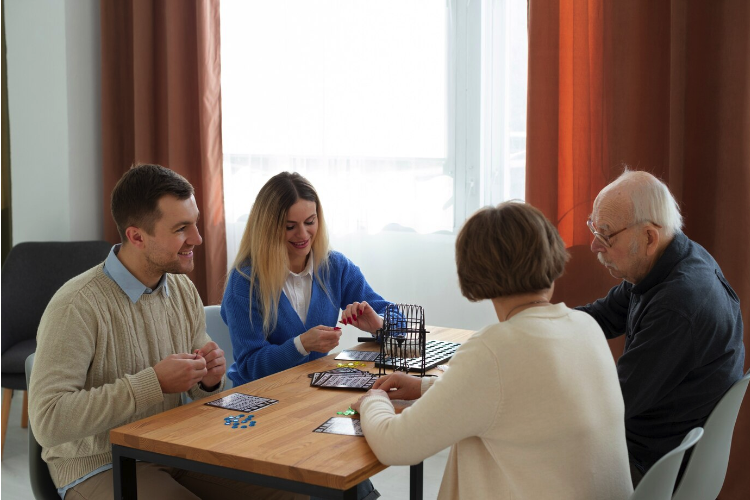Sharing Caregiving Responsibilities: A Path to Better Support
Caregiving can be overwhelming, but sharing responsibilities can make all the difference. Discover practical tips on how families can divide caregiving duties, improve communication, and ensure their loved ones receive the best care possible. Read the blog to learn more about the benefits of teamwork in caregiving.
TIPS
Erlyn A. Pinkston
10/22/20245 min read


Caregiving for a loved one can be a deeply rewarding role, offering opportunities for connection, care, and love. However, it can also be a challenge—emotionally, physically, and mentally—especially when one person carries the bulk of the responsibility. Many family caregivers feel isolated and overwhelmed, but it’s essential to remember that caregiving doesn’t have to be a solo effort. Sharing the duties among family members can make a significant difference, not only in easing stress but also in ensuring your loved one receives well-rounded care from people who care about them.
Whether you’re new to caregiving or have been on this journey for years, understanding how to collaborate effectively can improve both the caregiving experience and the quality of care provided. In this article, we'll dive into practical ways to share caregiving duties, foster better communication with family members, and ultimately provide the best support possible for your loved one.
1. Assign Roles Based on Strengths and Availability
Every family member has different strengths and availability, which can be a great asset when it comes to dividing caregiving duties. Not everyone can provide hands-on care, and that’s okay—there are various other ways family members can contribute. By assigning roles based on each person's skills, comfort level, and proximity, you can ensure that caregiving responsibilities are shared fairly.
Hands-on caregivers: If you have family members living nearby, they might be better suited for daily caregiving tasks like meal preparation, administering medication, or helping with bathing and dressing. Proximity makes them more accessible for in-person care, ensuring your loved one has consistent support.
Long-distance contributors: Relatives who live farther away can assist with tasks that don’t require being physically present. They might manage finances, schedule medical appointments, or conduct research on your loved one’s condition. They can also provide emotional support via phone or video calls, offering relief for those involved in daily caregiving.
Specialized skills: Consider if any family members have unique skills that could benefit caregiving. For instance, if someone has a background in healthcare, they might be more comfortable handling complex medical tasks or communicating with doctors.
When responsibilities align with each person's strengths and schedule, caregiving becomes more manageable and less stressful for everyone involved.
2. Create a Structured Caregiving Schedule
One of the most common challenges in caregiving is burnout, especially when one family member shoulders most of the work. Creating a structured caregiving schedule allows everyone to pitch in consistently and helps prevent any single person from becoming overwhelmed.
Use shared tools: Tools like Google Calendar, Care.com, or other caregiver management apps can be used to create and track the caregiving schedule. These platforms allow each family member to see who is responsible for specific tasks, minimizing confusion and preventing overlap.
Set realistic expectations: Not all family members will have the same amount of free time. When creating the schedule, take into account each person’s availability and other commitments. The goal is to create a balanced plan that works for everyone and covers your loved one’s needs effectively.
Include breaks and respite: Don’t forget to build in time for breaks or respite care. Everyone needs time to recharge, and by including designated time off in the schedule, you ensure that caregivers can rest without feeling guilty or worried about leaving their loved one.


3. Hold Regular Family Meetings to Improve Communication
Good communication is the cornerstone of effective caregiving. Family members need to be on the same page regarding their loved one’s care plan, needs, and any concerns that may arise. Scheduling regular family meetings is one way to ensure that everyone remains informed and engaged in the caregiving process.
In-person or virtual meetings: Whether family members are local or spread across the country, regular meetings can be held either in person or virtually (e.g., via Zoom or FaceTime). These meetings provide an opportunity for everyone to share updates, voice concerns, and discuss any issues that need resolution.
Active listening and empathy: During family meetings, it's important that everyone’s voice is heard. Actively listening to each person’s perspective and being empathetic to their concerns can help resolve conflicts before they escalate. Addressing any frustrations early on keeps communication open and prevents tension from building up.
Involve professional advice: If disagreements about caregiving arise, consider involving a professional, such as a social worker, geriatric care manager, or healthcare provider, who can provide guidance. They can help mediate conversations and offer objective advice based on your loved one’s health needs.
4. Don’t Be Afraid to Ask for Help
Even with a shared caregiving plan, there may come a time when additional help is needed. Whether you’re dealing with complex medical needs, a loved one’s declining health, or your own exhaustion, seeking professional assistance is often a crucial step in providing the best care.
In-home care services: Professional in-home care providers can assist with daily activities like personal care, companionship, meal preparation, and medical tasks. This can provide much-needed relief for family caregivers and ensure your loved one receives the specialized care they need.
Respite care: Respite care services allow family caregivers to take a short break, knowing that their loved one is in good hands. Respite can be for a few hours, a day, or even longer, depending on your needs. It’s essential for preventing caregiver burnout and maintaining your own well-being.
Local and community support: Look into local caregiving support services, nonprofits, or community programs that offer additional resources, including transportation, meal delivery, and support groups. These resources can be lifesavers for caregivers managing multiple responsibilities.
5. Focus on Your Loved One’s Needs, Not Family Conflicts
Caregiving can be emotionally charged, and it’s not uncommon for family conflicts to arise during the process. However, it’s important to keep the focus on your loved one’s well-being rather than allowing personal disagreements to overshadow their care.
Keep your loved one at the center: When tensions arise, remind family members that the goal is to provide the best possible care for your loved one. Their health and happiness should always be the priority, and decisions should be made with their best interests in mind.
Compromise and collaboration: Be willing to compromise when necessary. Everyone has their own opinions and preferences about how care should be provided, but working together to find a solution that meets your loved one’s needs is more important than “winning” an argument.
Seek professional advice: In more complex cases, such as when navigating legal or medical decisions, consider involving a third-party professional, such as a lawyer, financial advisor, or geriatric care expert, who can provide unbiased guidance.
Caregiving for a loved one can feel overwhelming at times, but when responsibilities are shared among family members, the task becomes much more manageable. By assigning roles based on each person's strengths, creating a schedule that works for everyone, maintaining open communication, and seeking professional help when needed, families can ensure their loved ones receive the best care possible.
At the heart of this process is teamwork, collaboration, and the understanding that caregiving is a shared responsibility. Together, families can create a support system that not only benefits their loved ones but also strengthens relationships and reduces stress for all involved.


Our Links
Mailing Address
P.O. Box 115 Garden Grove
CA 92842-115
